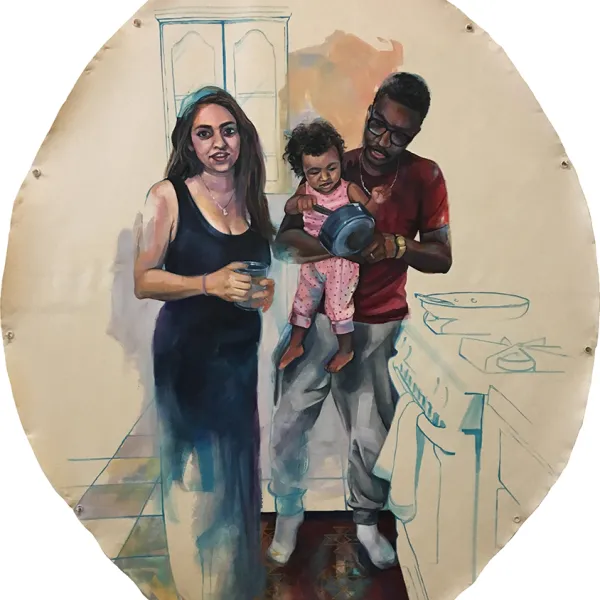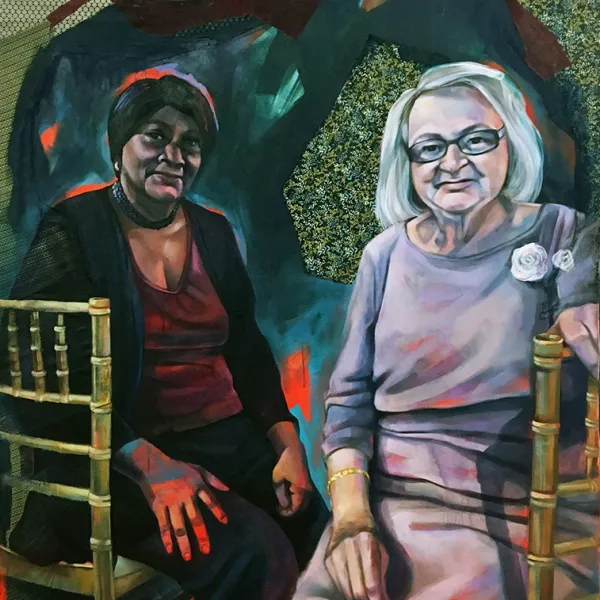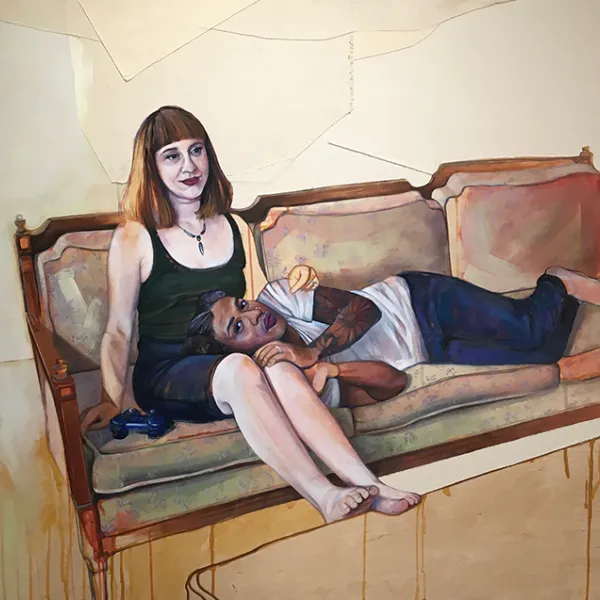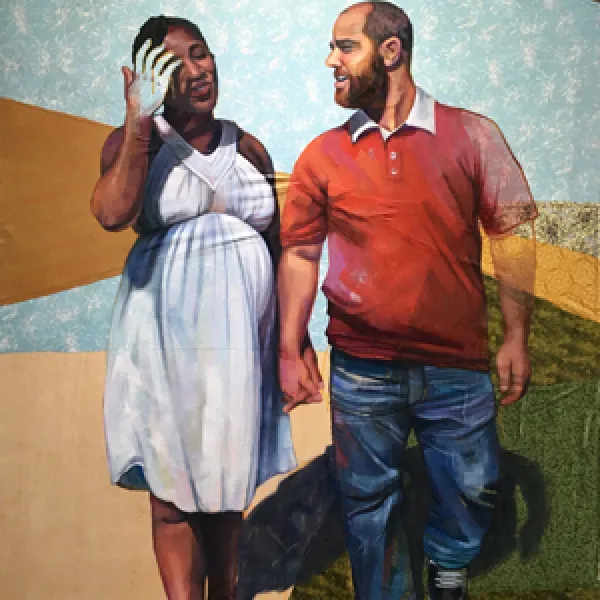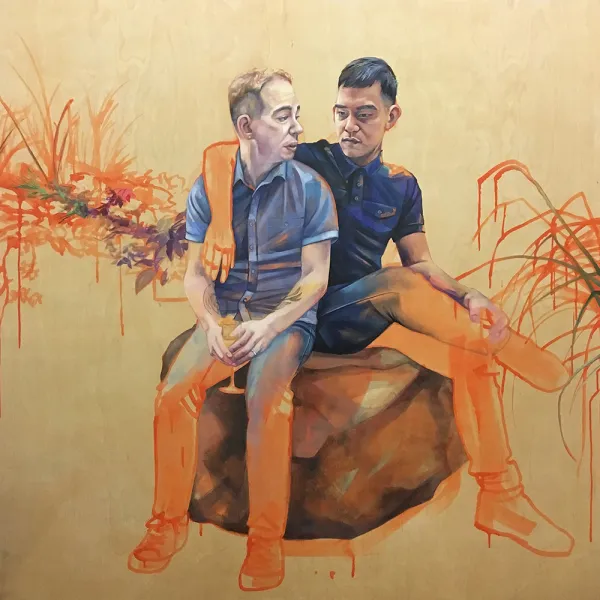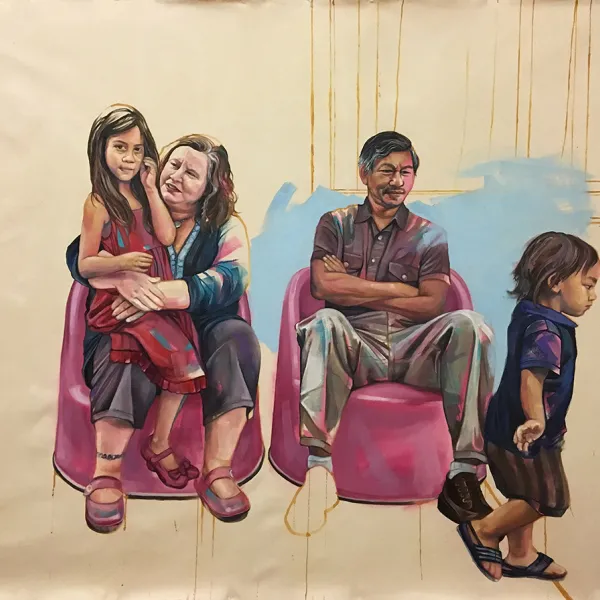Saturday, November 4, 6 – 8 p.m.
WAI Presents: A Conversation with Leslie Barlow
Wednesday, November 15, 7 p.m. | Sponsored by the Women's Art Institute
Leslie Barlow discusses Space Between Us with Women's Art Institute co-instructor Anna Garski and gallery director Nicole Watson
All events are free and open to the public.
Building upon her recent Loving series – mixed-media portraits of interracial families in the Twin Cities – Minneapolis painter Leslie Barlow continues to investigate the complex narratives of race and identity, and the politics of visibility and representation. This show introduces new paintings to the series, including images of the artist’s family, revealing her personal experiences as a mixed-race woman living in Minnesota.
Leslie Barlow is a practicing artist living and working in Minneapolis. Primarily an oil painter, Barlow's current work employs the figure and narrative elements to explore social issues such as race, representation, multiculturalism and "otherness." She investigates these themes through a lens of personal experience, often creating works depicting family, friends and people in her community. Her paintings reflect the subtle and not-so-subtle complexities of identity and individualism.
Barlow received her B.F.A. in 2011 from the University of Wisconsin-Stout and her M.F.A. in 2016 from the Minneapolis College of Art and Design. In 2016, she received a Minnesota State Arts Board Artist Initiative Grant, and that same year, she was the artist-in-residence at Whitworth University in Spokane, Washington. Her work has been included in solo and group exhibitions throughout the Twin Cities, most recently at the Minnesota Museum of American Art in St. Paul and at Public Functionary in Minneapolis. In addition to her studio practice, Barlow currently works as an Assistant Instructor at Juxtaposition Arts and she teaches drawing at the University of Minnesota.
ARTIST STATEMENT
Leslie Barlow
I am fascinated by the politics of representation – whose stories are represented in our imagery? Who decides which stories are told? How are those stories told, and from whose perspective?
This body of work is a continuation of a series I began to address some of these questions. I use portraiture to explore the representation of multiracial families and their relationships to reveal the tension that exists between these images and contemporary culture’s perception of what a “real” or “regular” family looks like. My paintings are a response to my own conflicted feelings of belonging, which are compounded by the limited representation of diverse narratives by and of people of color in art history and images in popular culture. This series was initially inspired by the 2013 General Mills Cheerios commercial featuring an interracial family and their mixed-race daughter. Immediately upon its debut, the commercial was deemed controversial and the racist backlash overwhelmed the commercial’s simple premise about a family – in my eyes, a “regular” family – and heart health. Still today, our society has responded to similar images in similar ways. The lack of representation of interracial and diverse family dynamics has impacted the way American people perceive family normalcy.
2017 marked the 50th anniversary of the Loving v. Virginia Supreme Court case, a staggering reminder of how recent anti-miscegenation laws remained in place in the United States. Loving v. Virginia has been a moving and important part of my understanding of the culture of discrimination surrounding interracial relationships and mixed-race people. The case was brought by a Virginia couple, Mildred and Richard Loving – a mixed-race black woman and a white man – each of whom had been sentenced to a year in prison for marrying each other. The strong link between fear and discrimination binds together the Loving era to the present day. Despite the outcome of the Loving case, the horrendous results of the 2016 presidential election and the persistence of racial and social divides in our country reminds us we have so much further to go.
Poet Audre Lorde writes, “it is not our differences that divide us. It is our inability to recognize, accept, and celebrate those differences.” I desire to make visible a community that represents the changing demographics of Minnesota. The invisibility of multiracial realities sends an unhealthy and inaccurate message to society in general, and in particular, to families with these lived experiences. It is important to increase the visual representation of multiracial realities in our cultural institutions. I use my artwork as a vehicle to talk about race with complexity and nuance, and from a place of vulnerability and personal experience.
The works in this exhibition feature both families to whom I am not related as well as immediate family members. I’m attempting to communicate something both unique and mundane in their presence and relationships. I have approached each painting differently, allowing the subjects to take center stage, drawing upon the commonalities between them while also honoring their differences. To do this, it became important for me to meet these families in their homes, embrace them in their spaces and within their experiences. My compositions became moments of the everyday: some intimate, some reminiscent of traditional family portraits, some fleeting and barely captured. Through the use of oil paint and sewn fabric I weave together the complexities of the lives of these families, allowing spaces to shift from layers of resolve to exposed wood and canvas, symbolizing intersectional narratives in flux. Having agency over the representation of the narratives in these works allows space for questions and conversation about race, race relations, identity and family. Ultimately, when exhibited together, the works communicate a new story, one that challenges superficially-simple narratives, celebrates that which makes us unique, and underscores the right to know a love without barriers.
Leslie Barlow discusses Space Between Us with Women's Art Institute co-instructor Anna Garski and gallery director Nicole Watson.
Image Gallery
Click an image to view in larger size

